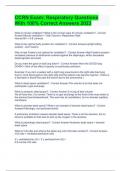Ccrn respiratory - Study guides, Class notes & Summaries
Looking for the best study guides, study notes and summaries about Ccrn respiratory? On this page you'll find 377 study documents about Ccrn respiratory.
Page 3 out of 377 results
Sort by
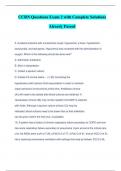
-
CCRN Questions Exam 2 with Complete Solutions Already Passed
- Exam (elaborations) • 32 pages • 2023
- Available in package deal
-
- $12.49
- + learn more
CCRN Questions Exam 2 with Complete Solutions Already Passed 2. A patient presents with a productive cough, hypoxemia, a fever, hypotension, tachycardia, and tachypnea. Hypoxemia was corrected with the administration of oxygen. Which of the following should be done next? A. Administer antibiotics. B. Start a vasopressor. C. Collect a sputum culture. D. Initiate 0.9 normal saline. - (D) Correcting the hypotension (with isotonic fluid resuscitation in order to maintain organ perfusion) i...
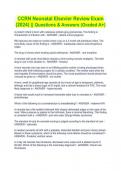
-
CCRN Neonatal Elsevier Review Exam (2024) || Questions & Answers (Graded A+)
- Exam (elaborations) • 13 pages • 2024
-
Available in package deal
-
- $11.00
- + learn more
CCRN Neonatal Elsevier Review Exam (2024) || Questions & Answers (Graded A+) CCRN Neonatal Elsevier Review Exam (2024) || Questions & Answers (Graded A+) A preterm infant is born with cutaneous pinkish-gray granulomas. This finding is characterstic of infection with - ANSWER - listeria monocytogenes Rib fractures are noted on routine chest x-ray on a 3 month old premature infant. The most likely cause of this finding is - ANSWER - inadequate calcium and phosphorus intake The drug of ch...
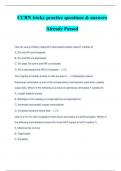
-
CCRN tricky practice questions & answers Already Passed
- Exam (elaborations) • 65 pages • 2023
- Available in package deal
-
- $12.49
- + learn more
CCRN tricky practice questions & answers Already Passed How do young children respond to decreased cardiac output? (cardiac 3) A. SV and HR are increased B. SV and HR are decreased C. SV stays the same and HR is increased D. SV is decreased and HR is increased - C The majority of cardiac arrests in kids are due to - Respiratory failure Adrenergic stimulation is one of the compensatory mechanisms used when cardiac output fails. Which of the following is a result of adrenergic stimulation...
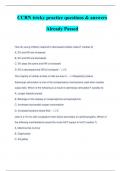
-
CCRN tricky practice questions & answers Already Passed
- Exam (elaborations) • 65 pages • 2023
- Available in package deal
-
- $12.49
- + learn more
CCRN tricky practice questions & answers Already Passed How do young children respond to decreased cardiac output? (cardiac 3) A. SV and HR are increased B. SV and HR are decreased C. SV stays the same and HR is increased D. SV is decreased and HR is increased - C The majority of cardiac arrests in kids are due to - Respiratory failure Adrenergic stimulation is one of the compensatory mechanisms used when cardiac output fails. Which of the following is a result of adrenergic stimulation...
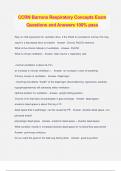
-
CCRN Barrons Respiratory Concepts Exam Questions and Answers 100% pass
- Exam (elaborations) • 21 pages • 2024
- Available in package deal
-
- $12.49
- + learn more
CCRN Barrons Respiratory Concepts Exam Questions and Answers 100% pass Rely on mild hypoxemia for ventilator drive. if the PaO2 Is corrected to normal, this may result in a decreased drive to breathe - Answer- Chronic PaCO2 retainers What is the clinical indicator of ventilation - Answer- PaCO2 What is minute ventilation - Answer- tidal volume x respiratory rate +normal ventilation is about 4L/min an increase in minute ventilation = - Answer- an increase in work of breathing Primary musc...
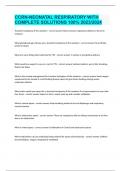
-
CCRN-NEONATAL RESPIRATORY WITH COMPLETE SOLUTIONS 100% 2023/2024
- Exam (elaborations) • 5 pages • 2023
- Available in package deal
-
- $12.99
- + learn more
CCRN-NEONATAL RESPIRATORY WITH COMPLETE SOLUTIONS 100% 2023/2024 Transient tachypnea of the newborn - correct answer Most common respiratory distress in the term newborn What gestational age will you see a transient tachypnea of the newborn - correct answer Term till late preterm infants What are some things that could lead to TTN - correct answer C-section or precipitous delivery What would you expect to see on x-ray for TTN - correct answer Sunburst pattern, perry hilar streaking, ...
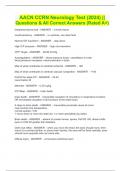
-
AACN CCRN Neurology Test (2024) || Questions & All Correct Answers (Rated A+)
- Exam (elaborations) • 8 pages • 2024
-
Available in package deal
-
- $9.69
- + learn more
AACN CCRN Neurology Test (2024) || Questions & All Correct Answers (Rated A+) AACN CCRN Neurology Test (2024) || Questions & All Correct Answers (Rated A+) Intraparenchymal bolt - ANSWER - in brain tissue Ventriculostomy - ANSWER - in ventricle, can drain fluid Normal ICP waveform - ANSWER - step down High ICP pressure - ANSWER - high mid waveform CPP Target - ANSWER - 60-80 mmHg Autoregulation - ANSWER - blood pressure drops- vasodilation in brain blood pressure increa...
CCRN Exam: Respiratory Questions With 100% Correct Answers 2023
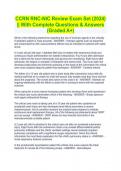
-
CCRN RNC-NIC Review Exam Set (2024) || With Complete Questions & Answers (Graded A+)
- Exam (elaborations) • 11 pages • 2024
-
Available in package deal
-
- $10.50
- + learn more
CCRN RNC-NIC Review Exam Set (2024) || With Complete Questions & Answers (Graded A+) CCRN RNC-NIC Review Exam Set (2024) || With Complete Questions & Answers (Graded A+) Which of the following statements regarding the use of inotropic agents in the critically I'll pediatric patient is most accurate - ANSWER - Inotropic agents such as dopamine and norepinephrine with vasoconstictive effects may be indicated in patients with septic shock A 4 year old girl with type 1 diabetes Mel lotus is ...
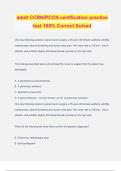
-
adult CCRN/PCCN certification practice test 100% Correct Solved
- Exam (elaborations) • 21 pages • 2024
- Available in package deal
-
- $12.49
- + learn more
adult CCRN/PCCN certification practice test 100% Correct Solved One day following posterior spinal fusion surgery a 35 year old female suddenly exhibits restlessness, labored breathing and acute chest pain. Her heart rate is 122/min., she is afebrile, and exhibits slightly diminished breath sounds on the right side. The findings described above should lead the nurse to suspect that the patient has developed: A. A spontaneous pneumothorax B. A pulmonary embolus C. Aspiration pneumonia D...

Did you know that on average a seller on Stuvia earns $82 per month selling study resources? Hmm, hint, hint. Discover all about earning on Stuvia



